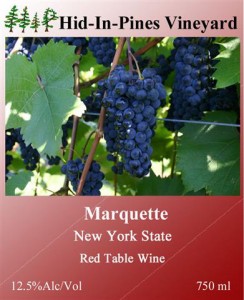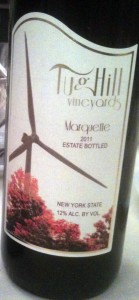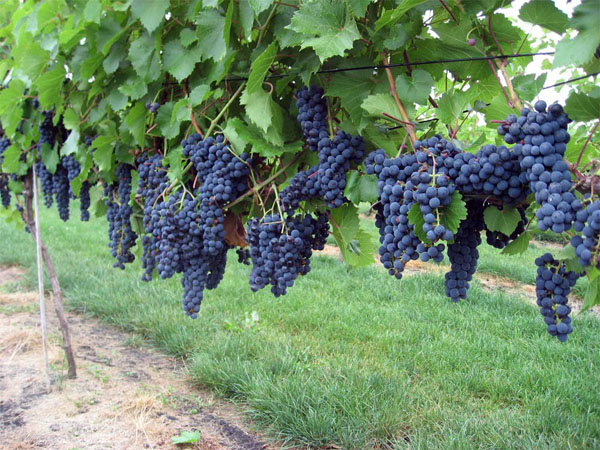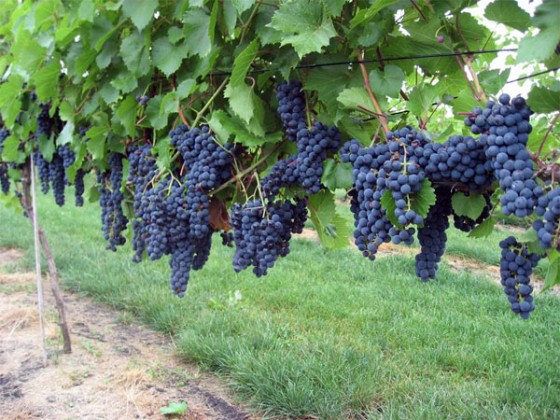The prospect of growing and making red wine in cool climates meets with some well-known challenges — reaching adequate ripening levels, controlling acidity, getting good color extraction, as well as surviving disease and predators. Until just a few years ago, it might have been considered madness to conceive of, let alone attempt to pursue, the table red in places where the winter snow can get as deep as the high trellis wire, or where there can be bare ground on days with temperatures so cold that cars and equipment won’t start until the morning sun has been on them for a bit.
While madness and genius may go hand-in-hand, I’ve met a bunch of pretty smart people who not only believe this is possible, but are compiling the evidence, and the accolades to prove it. I happen to have also drunk the kool-aid, and made a couple of batches of it myself.
The Marquette wine grape was released in 2006 by the University of Minnesota breeding program and shortly thereafter nursery orders were being filled for shipment in northern states from Minnesota to Maine. These vines were planted with the promise of able bodied red wine in the 12 - 14% alcohol range, with manageable acidity, and no reported problem with color retention. Common tasting attributes are cherry fruit, black pepper, and meaty/savory notes. Several leafs after introduction, wineries have have been through their test phases and have started to produce wine commercially. Products are finding local acceptance and gathering critical acclaim.
Marquette is already surprising palates, and this is only the very beginning.
A rigorous hand breeding program produced this vine and years of field trials led to its selection for release. Marquette’s parentage is oft touted because of its hip and revered grandparent pinot noir. I however, also take notice the other side of the family, where a certain wild riparia #64 got involved with great-grandparent Carmine, a Californian sprout that is the child of great-great grandparents merlot and cabernet sauvignon…I believe you might know those folks?
It’s irritating to have to dredge up the heritage of well known grape varieties to get someone to sample a new wine, but its worth it when they taste it, their eyes light up, followed by a widening of their palates, and hopefully their minds. We won’t get into the topic of bias against inter-specific hybrids, and interbreeding, as we will save that for another time. The proof is in the glass they say, and early results from young vines have been showing quite well.
Recently tasting a local Marquette against an established old house German pinot noir, I and most consumers would choose the former, a juicy pleasing quaff, rather than the latter which presented as a raspberry jam jar rinsed in old dishwater. At the 2012 Cold Hardy Wine competition, Marquette frequented the medal scene, and Vermont’s Shelburne Vineyard took a Best in show for its 2010 Reserve. It’s not just the near-arctic wine buffs who are taking notice. The folks at the Napa Valley Register reviewed a bunch of bottles late last year, and were very pleased with what they found.
I’ve had the chance to make Marquette only a couple of times, and as an amateur winemaker, I can say, that I would love to be able to make wine with it every year. I’m hoping my chances are improving as acreage is maturing, as well as expanding. In the northeast, 2010 was a great ripening year with just enough rain to support a good crop, but with constant warm dry days through the whole season. 2011 was a rough year, cool and damp the entire season, with the double hit of Tropical Storms Irene and Lee swamping the beginning of harvest. 2012 was a super dry scorcher, holding down yields showing desiccation of clusters in some places, and it will be interesting to see what becomes of this vintage.
While I have my own experience with Marquette in the vineyard and the cellar, I thought I should reach out to a few folks who have also been working with it as well. I had a short list of my own to start with, but decided to touch base with Andy Farmer of Northeast Vine Supply, a major supplier of cold-hardy plant material, to see if he had any thoughts on the variety, and if he could point me at some folks who had it in the ground for long enough to be making wine in New York. I first caught up with Andy by phone as he is in one of the busiest parts of his year, doing pruning work all over the northeast. Marquette plantings are increasing in a number of northern states, Wisconsin was a big purchaser last year, and in Quebec, it is also beginning to gain ground. He pointed me in a few directions and I planned to meet up with him again to compare notes in Rochester, NY at the Viticulture 2013 Conference.
[pullquote_left]
Marquette is already surprising palates, and this is only the very beginning.
[/pullquote_left]
When I asked what Andy thought about people’s excitement levels about Marquette, now that there was a red grape that everyone can grow, he cautiously reminded me that his biggest concern is that the vine is prone to early bud break, and as such might not be suitable for sites that regularly experience late spring frosts. It is hardy enough to stave off -30F in the depths of winter, but there is still the danger of late-season freeze to tender buds and shoots. At least one grower is reported to have removed vines from an unfavorable site that was consistently being bitten each year. Andy’s concern was echoed by Gary Burmaster at Liberty Vineyards & Winery in Sheridan, NY near the shore of Lake Erie. “They have an early bud push which may increase the possibility of being damaged by spring frost. The secondary buds will push fruit. The tender vegetation seems to handle frost better than other varieties (almost like they have a little “antifreeze” in them).”
 Burmaster also noted that Marquette was slow to establish in his vineyard. That is something that I heard from some other folks at the conference in Rochester, and at this point I must point out the several observed irregularities with regard to this grape. At my site it is by far the most vigorous, in low-vigor soil. It had not even swelled buds when my La Crescent had three inch shoots burned off by the 2012 spring freeze. Some folks report pretty low yields on their plantings, while others like Richard LaMoy at Hid-In-Pines reports bumper yields in his trellis experiments. While some folks on Vertical Shoot Positioned (VSP) trellis barely reached 22 Brix in 2012, other folks were seeing a few points higher on Top Wire Cordon, while some are even growing vines under hoop-houses and gaining brix levels close to 30 degrees. So early in the game, so early in the vine’s lives, it may be hard to pin down patterns, but site and soil influence seem apparent, the training environment obviously has impact, and scientists under the auspices of the Northern Grape Project, are working on compiling and analyzing the data.
Burmaster also noted that Marquette was slow to establish in his vineyard. That is something that I heard from some other folks at the conference in Rochester, and at this point I must point out the several observed irregularities with regard to this grape. At my site it is by far the most vigorous, in low-vigor soil. It had not even swelled buds when my La Crescent had three inch shoots burned off by the 2012 spring freeze. Some folks report pretty low yields on their plantings, while others like Richard LaMoy at Hid-In-Pines reports bumper yields in his trellis experiments. While some folks on Vertical Shoot Positioned (VSP) trellis barely reached 22 Brix in 2012, other folks were seeing a few points higher on Top Wire Cordon, while some are even growing vines under hoop-houses and gaining brix levels close to 30 degrees. So early in the game, so early in the vine’s lives, it may be hard to pin down patterns, but site and soil influence seem apparent, the training environment obviously has impact, and scientists under the auspices of the Northern Grape Project, are working on compiling and analyzing the data.
So far, their research reveals that Marquette seems to do best when it’s vigor issues are addressed and training allows for enough nodes to keep the plant occupied with healthy growth , and deliver good crop load.
Top wire cordon (TWC) and Geneva Double Curtain (GDC) are moving toward favored positions in the training plans. Tim Martinson who is a Senior Cornell Extension associate supports this trend and conveyed “…high training systems and possibly cane pruning (we’ll see) may save growers some labor and costs, while not impacting fruit quality. Low-trained VSP on cordons is great if you can put the time and labor into canopy management, but works less well if you don’t do the right canopy management procedure (tucking, positioning, summer hedging) at the right time. I think it’s [Marquette] a variety with a great future.”
Gary Akrop at Ledge Rock Hill Winery nestled in the southern Adirondacks of Corinth, NY is on board with these findings, as he had already considered a trellis transition away from VSP to GDC, but his row widths are too small for the extra wires, so he’ll be going for TWC instead in order to help increase his yield, and appease the vigor of the vines with real estate. Based on his report, raising the shoot and fruit zone will also protect the sensitive areas from his sheep who mow the vineyard floor, but have shown too much interest in taking on vine pruning duties as well.
On top of the place based variation, Marquette also seems to be a “winemaker’s grape”, in that it manages to be flexible in the hands of its caretakers. In the course of my explorations of the past few years, and with input from recent discussions, I am aware of Marquette made in: an un-oaked wild-fermented fresh-acid style, as a saignée Rosé to bleed off young pink wine and concentrate the main batch, extended maceration with barrel aging, and even fortified port-style wines.
Because of it’s flexibility it becomes easy for winemakers to push the fruit in the direction that they imagine for it, but I wonder if in the process of trying to deliver something that resembles a recognizable mainstream red, that Marquette’s unique potential will be obscured by desires. For example, I have heard it referred to as a Cotes du Rhone-like, because of the the fruit, black pepper and savory notes. I get why this may be the case because of the profile, especially with the purple hue that it can inhabit. However, I get none of the blue and black fruit notes that I associate with syrah. Red cherry flavors are main in Marquette, and its capability to shape shift, makes me think of Grenache but the sometimes sour cherry notes, plus the sanguine and savory edges, take me towards Zweigelt, only with racier acidity and less tannin.
 Some may like to say that they have the best angle on how to wrangle this new beast, but I am very hesitant to see Marquette pinned down to a specific yield and style, in French AOC fashion. It is decades too soon for that, and in the meantime experimentation is the necessity of invention. Besides, I am of a strong mind that while some places and cellars will be able to produce a fine varietal wine with this grape, I would hope that unique and distinct blends could be made every year, with Marquette as a main component.
Some may like to say that they have the best angle on how to wrangle this new beast, but I am very hesitant to see Marquette pinned down to a specific yield and style, in French AOC fashion. It is decades too soon for that, and in the meantime experimentation is the necessity of invention. Besides, I am of a strong mind that while some places and cellars will be able to produce a fine varietal wine with this grape, I would hope that unique and distinct blends could be made every year, with Marquette as a main component.
Paul Deninno of Bashakill Vineyards, reported doing a small run blended with Noiret in 2010 that he described as having black pepper, raspberry and currant notes, which were pleasing enough to have sold right out. In the challenging, cool,damp 2011 vintage (and with a wet harvest, to boot), the Marquette fruit that I brought home was clean, but was lean and lacking in the body or quality that I thought could stand alone. So mine went into a blend with equal part Leon Millot, and a minor portion of a Frontenac Gris Rosé. While not the bigger wine that Marquette is capable of in warmer years, I think it does a pretty handy impression of a Loire Valley Pinot Noir, and the few industry folks that have tasted it, think that it works.
One of the other folks that I was directed to contact, because his amateur made ( soon-to-be Pro ) Marquette, was Gerry Barnhart of Victory View Vineyard in Schaghticoke, NY, who has had three vinifications to date. He does not do any chemical de-acidification, but does rely on malo-lactic fermentation to soften the wines more naturally.
2012 was a dry, warm year, and is in his tank now, coming in at 27 Brix, a pH of 3.7, and a TA of 8g/l…those are pretty nice numbers for a red wine in a northern clime. The 2011 vintage was a bit of a bust due to the tropical storms, but Barnard was able to salvage the harvest by making a home port style wine that he’s very happy with. The warm season of 2010 yielded a brix of 27.5, a pH of 3.38, and a TA of 9g/l, which turned out a wine that I had a chance to taste while at Viticulture 2013. Their bottle I sampled from, along with Andy Farmer, had been open for a while, and the low-sulfite treatment seemed to allow some oxygen incursion, but did not inhibit the rich cherry and wood spice notes on the nose, a nice round mid-palate of red fruit compote, and while the alcohol showed a bit, I was impressed by the overall weight and balance.
My take-away as a wine lover, conscious taster, and small-time winemaker, is that there is serious potential and impressive variety that can be associated with the vinification of Marquette. Maybe someday a “preferred style” will emerge, but in the meantime, I think that we will all enjoy bearing witness to, and sampling from the evolutionary process. It also may turn out, that there is no “one way”, and that in fact, Marquette may serve us in many shades, while still building a role as as the red wine foundation of cold climate viticulture. The 2012 wines are in the tanks and barrels now, with the pipeline soon to follow, so I recommend folks plan to taste the results from this warm, dry vintage once they become available.


